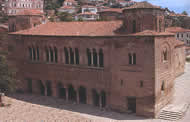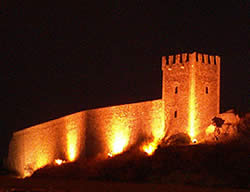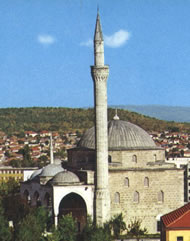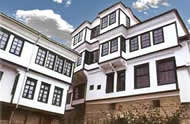|
The coming of Clement to Macedonia marked the beginning of a new period of art for the region. Objectively speaking, the history of art in these territories represented a history of church art. The influence of Byzantine art is indisputable, although artistic works created during the time of Clement and the time of Tsar Samuil are exceptions. The construction of the Church of St. Sophia in Constantinople had a decisive influence on establishing criteria for building temples in areas the Orthodox Church dominated. However, during the Macedonian Empire of Samuil, new characteristics can be noticed in Macedonian architecture, long after the Byzantine architectural school had run its course. This suggests the existence of a separate Macedonian school of architecture.
With the construction of St. Panteleimon in Ohrid by Clement (893), downhill from the Ohrid Fortress, the Macedonian Slavs gained not only their first great religious and educational center, but also the conditions necessary to develop their aesthetic feelings, accepting and continuing existing artistic forms, but expanding into new directions, as well. For example, Clement used a ruined three-conchae church for the foundation of St. Panteleimon, added some original parts, and obtained new "oval" forms. A similar procedure was applied in constructing the Church of St. Archangel, built on the southern shore of Lake Ohrid and later renamed the Monastery of St. Naum. Later on, in the 10th and 11th centuries, the building of three-conchae churches was abandoned and four-conchae churches began to be built (the Church of the Holy Virgin Eleussa near Veljusa), as well as churches of basilica arrangement, such as the Church of St. Achilles on the Island of Achilles in Prespa Lake, the Church of St. Sophia in Ohrid, the Church of the Holy Virgin in the Strugan village of Vranista, and the Church of St. Leontes near Strumica.
  One of the architectural masterpieces of Macedonia from the early period of Slavonic culture is the Church of St. Sophia in Ohrid, renovated by Archbishop Leo between 1037 and 1056. Its size and the arrangement of the fresco-paintings in the sanctuary seem to suggest that it was constructed as a cathedral. It began as a three-nave basilica with a transept, dome, and nartex, suggesting a transition to the civil construction of the 12th to the 14th centuries, when churches usually had a square base foundation and cruciform construction. The beauty of St. Sophia lies in its exo-nartex with its open galleries and two towers ending in small domes. It is interesting to note that the Church of St. Pantelejmon in Nerezi (1164) has a similar cruciform layout, but is enriched by five domes, characteristic of nearly all monasteries surrounding Skopje and the churches in Matejce and Staro Nagoricane near Kumanovo. In general, the five-dome cruciform church represents one of the main characteristics of mediaeval architecture in Macedonia . The diversity of architectural forms in Macedonia was enriched by the late 13th century church dedicated to the Holy Virgin Perivleptos in Ohrid -- a single-nave church built to a very strict and precise plan, in which the voluminous mass of the structure was carefully structured to give a harmonious balance overall. One of the architectural masterpieces of Macedonia from the early period of Slavonic culture is the Church of St. Sophia in Ohrid, renovated by Archbishop Leo between 1037 and 1056. Its size and the arrangement of the fresco-paintings in the sanctuary seem to suggest that it was constructed as a cathedral. It began as a three-nave basilica with a transept, dome, and nartex, suggesting a transition to the civil construction of the 12th to the 14th centuries, when churches usually had a square base foundation and cruciform construction. The beauty of St. Sophia lies in its exo-nartex with its open galleries and two towers ending in small domes. It is interesting to note that the Church of St. Pantelejmon in Nerezi (1164) has a similar cruciform layout, but is enriched by five domes, characteristic of nearly all monasteries surrounding Skopje and the churches in Matejce and Staro Nagoricane near Kumanovo. In general, the five-dome cruciform church represents one of the main characteristics of mediaeval architecture in Macedonia . The diversity of architectural forms in Macedonia was enriched by the late 13th century church dedicated to the Holy Virgin Perivleptos in Ohrid -- a single-nave church built to a very strict and precise plan, in which the voluminous mass of the structure was carefully structured to give a harmonious balance overall.
The secular architecture of this time was generally insignificant. There are no remnants which would serve as a basis for shaping a picture of the palaces, houses, or even towns of the early mediaeval period in Macedonia. There are, however, ruins of mediaeval fortresses, built in large carved rectangular stone blocks. Ohrid Fortress is considered to be the oldest and best-preserved fortress in Macedonia. Roman historians mention Ohrid as a town of fortresses, but the remaining ruins visible today chiefly belong to fortifications erected by Samuil. The height of its ramparts is in the range of 10 to 16 meters, originally protected by numerous towers -- the ruins of 18 towers and four gates remain. The fortress itself was often renovated and new parts added to it during the mediaeval period.
  Skopje Fortress is a second preserved example of secular architecture in Macedonia. Archaeological excavations have proven that the site of the fortress was inhabited as early as 4,000 years ago. Likewise, research proves that the large defensive wall of the fortress was built during the time of Emperor Justinian, in about 535. The fortress was constructed from the stones of the town of Scupi, destroyed by the disastrous earthquake of 518. The only parts of this fortress which remain are about 120 meters of ruins and three towers: one square, one rectangular, and one circular. Skopje Fortress is a second preserved example of secular architecture in Macedonia. Archaeological excavations have proven that the site of the fortress was inhabited as early as 4,000 years ago. Likewise, research proves that the large defensive wall of the fortress was built during the time of Emperor Justinian, in about 535. The fortress was constructed from the stones of the town of Scupi, destroyed by the disastrous earthquake of 518. The only parts of this fortress which remain are about 120 meters of ruins and three towers: one square, one rectangular, and one circular.
The age of the mediaeval town accompanying the fortress has not been determined. It is hypothesised that the fortress was renovated and expanded in the 11th century, during the second period of Byzantium rule over the region. The fortress was refitted to protect Skopje, as an economic site and strategic border town, from attacks by neighboring states and barbarians like the Scythians and Pechenegs of the north. The remnants of the Byzantine fortress later served as the base for the construction of a new, fortified town. The traveller Evliya Celebi writes that Skopje was a fortified town, with a double outer wall built, like the town gate, with stone which "shone as if polished."
  The subjugation of Macedonia under Ottoman authority both hindered the development of architecture and encouraged it to adapt to the requirements of Islam and Ottoman urban life. The church was replaced by the mosque as the centre of religious architecture. Fortified towns gave way to open settlements where the inn, the hamam (Turkish bath), and the mosque, concentrated as a group of public buildings, became a typical characteristic of the Ottoman urban planning. These buildings became the central point of a bazaar; with the addition of a bezisten (a domed marketplace) and covered markets, as typified by Arab markets, the inn, hamam, mosque, and bezisten became the pivot of urban life. This was the greatest influence of Ottoman architecture on Macedonian architects during Ottoman rule. The subjugation of Macedonia under Ottoman authority both hindered the development of architecture and encouraged it to adapt to the requirements of Islam and Ottoman urban life. The church was replaced by the mosque as the centre of religious architecture. Fortified towns gave way to open settlements where the inn, the hamam (Turkish bath), and the mosque, concentrated as a group of public buildings, became a typical characteristic of the Ottoman urban planning. These buildings became the central point of a bazaar; with the addition of a bezisten (a domed marketplace) and covered markets, as typified by Arab markets, the inn, hamam, mosque, and bezisten became the pivot of urban life. This was the greatest influence of Ottoman architecture on Macedonian architects during Ottoman rule.
Evliya Celebi records a total of 120 temples in Skopje, 45 of which large mosques. The best known among these include the Isaac Bey Mosque, built in 1438; the Mosque of Murad Haynukar, built in 1436; the Mosque of Koca Mustafa Pasha, built in 1491; the Mosque of Burmali, built in 1495, but since destroyed; and the Mosque of Jahja Pasha, built in 1504 and including a 50-meter high minaret. Bitola was enriched by the Isac Mosque, built over 1508-09; the Yeni Mosque, built in 1559; and the Mosque of Yahdar-Kadi, built in 1562 by Koca Sinan, the most prominent Ottoman architect of the time. Celebi lists 70 Moslem mosques in Bitola. Later, in the 17th century, the Colourful Mosque was built in Tetovo, richly decorated with beautiful ornaments.
Secular architecture includes the Kursumli An in Skopje, covered by numerous small domes coated with kursum (Turkish for lead). The Suli An in Skopje has also been preserved to the present. Particularly attractive were the Daut Pasha Amam baths, the Cifte Amam baths in Skopje, and the bezistens in Bitola and Stip.
Also characteristic of the Turkish architecture throughout the Ottoman Empire were turbes (burial chambers), in which distinguished Ottomans were buried, and tekes (convents), a sort of a dervish monastery. Particularly fine architectural examples of turbes included that of Mustafa Pasha in the Isaac Bey Mosque in Skopje, the open Kral K'zi turbe, and the eight-metre domed turbe in Gazi Baba, Skopje. Outstanding among the dervish convents are the Sultan Emir Tekke in Skopje and the Arabati-Baba Teke in Tetovo. Unfortunately, there are no preserved examples of individual domestic dwellings from the mediaeval or early to mid-Ottoman periods. It is theorised that such dwellings were constructed with materials which did not stand up to the test of time. However, fine examples of 19th and early 20th century houses still remain in Ohrid, Krusevo, Kratovo, Bitola, Veles, Prilep, and Resen, testimonies to how architecture was adapted to respond to the specific needs of Macedonian conditions. The houses of Ohrid and Krusevo are particularly noteworthy.
  A number of early 19th century houses in Ohrid survive, generally two to three storeys with a stone ground floor and upper floors of wood. These houses are characterised by numerous windows, wide porches, and belvederes. A number of early 19th century houses in Ohrid survive, generally two to three storeys with a stone ground floor and upper floors of wood. These houses are characterised by numerous windows, wide porches, and belvederes.  Due to local climate, terrain, and geography, houses were placed close to each other and constructed to face Lake Ohrid. They are usually coloured white and are characterised by boldly arranged facades supported by consoles, wooden eaves, and several additional details. Due to local climate, terrain, and geography, houses were placed close to each other and constructed to face Lake Ohrid. They are usually coloured white and are characterised by boldly arranged facades supported by consoles, wooden eaves, and several additional details.
In 1927, Le Corbusier visited Krusevo and was delighted by the 19th century architecture unique to this small town. The densely-packed houses are characterised by magnificent architectural arrangements. Together they create a harmonious whole of various architectural elements and vivid colours, mostly light blue or light yellow. The arrangements are supplemented by projecting balconies, wide belvederes, built-in wardrobes, porches with stone-fitted floors, and large, heavy wooden gates.
From Macedonia Yesterday and Today by Jovan Pavlovski & Misel Pavlovski (www.mian.com.mk)
Translated by: Zaharija Pavlovska |